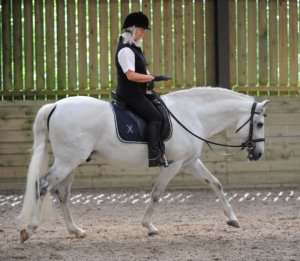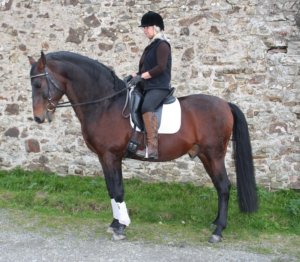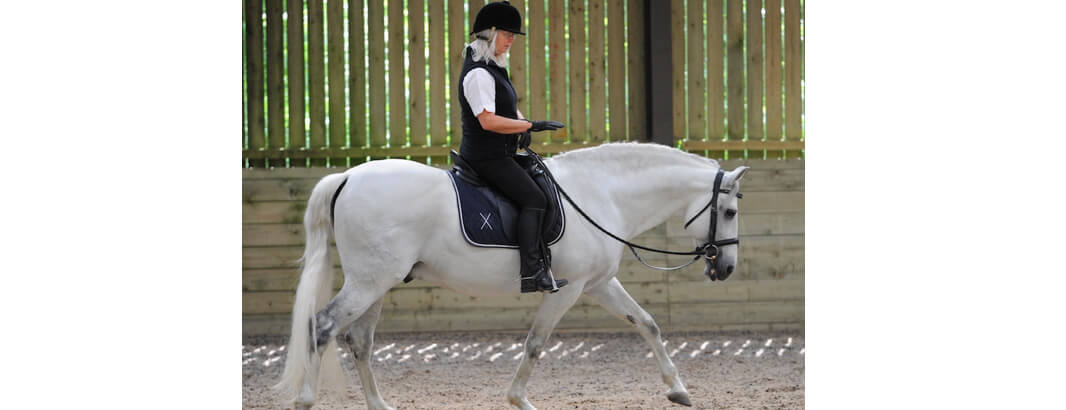Pt. 4: Breathe into Your Transitions
by Jenny Rolfe
This month we’re going to cover breathing as an aid to better transitions. As described in my last article, take a few moments to check your posture from ‘top-to-toe.’ Focus on your core breathing and feel the building of stability with the inward breath and energy release with your outward breath. Take a deep stress releasing sigh, allowing the next inward breath to happen naturally. When you sigh, it is just a gentle release of energy through the body. This is a different feel to the outward breath which directs the stronger energy, from the core towards the horse, which will instigate his movement.
Breathe into Walk

Once in the saddle stand at halt for a moment with top- to-toe focus, then with an allowing contact on the reins, take a deep inward breath, followed by a more vigorous outward breath. This exhalation will ripple down your spine releasing through your core and encourage the horse to move forwards. This movement for the rider is similar to sitting on a swing and pushing it forwards and upwards, but it is much more subtle. If your horse does not respond, use your legs once and, if needed, back up with a tap of the whip on your own leg. Very quickly the horse will tune into this sequence of aids and respond from your breath alone. Remember the high sensitivity of your horse and tune into his mind to build your connection. When the horse is walking forwards, continue breathing naturally and rhythmically with every few strides. Imagine you are jogging and supporting your running with steady inhalation and exhalation.
Breathe into Halt

When you ask the horse to halt, your deeper inward breath will lengthen and strengthen your spine, creating stability and acting as a half halt. As the horse responds, increase the inward breath, close your fingers on the reins and ask him to halt. Once the horse is standing still, release the pressure of your fingers on the reins, so he can stand immobile in a good self-carriage. Gain his focus with your steady core-breathing. He should be calm and still, yet ready to move on your next deeper, energizing exhalation. If the horse is allowed to stand with only a light contact with the reins his forward movement can be in lightness and not bearing down.
Transitions—From Walk to Trot
Prepare by walking forwards with a good energy and rhythm. Before you trot forwards make sure the horse is relaxed into a steady contact with the reins. This will not be created by pulling back with your hands, but from the energy from the hind limbs. This active motion from behind will increase movement through all his joints and will mobilize his spine. This flow of energy will create a release through his back. His head and neck will arch and lengthen naturally, as a result of a calm attentive mind and good positive energy. Breathe steadily, in a natural rhythm, becoming more aware of expanding your core on the inward breath and releasing gently through your core on exhalation. Encourage the horse to come and ‘sit under you,’ bringing his hind legs through to develop better self carriage. In this way his forehand and shoulders will feel lighter. Picture a see-saw with two people, both weighing the same, sitting at either end. Now picture a heavier person who makes the see-saw tip down with the extra weight. While one end will lower, the other end will elevate. This is similar to the horse when he uses more energy to propel and elevate; his forehand will lighten and he will feel more freedom in his shoulders.
When you prepare to trot, first make sure you have a marching, energetic walk. Take a deeper inward breathe to re-balance and then allow a stronger breath outwards. Feel the energy ripple down through your spine, which will release and mobilize your seat. If the horse does not respond then use your legs, just once, and re-enforce with a tap of the whip if needed.
Focus on your regular natural breathing and use the deeper outward breath to instigate more energy. Tap once with your legs if the horse is not attentive to your energizing breath. The horse will soon tune into your breathing alone which will enable your legs just to hang in a relaxed way down either side of the horse’s rib cage. In this way your natural balance will not be continually disrupted. If your horse tries to pull and get too strong in your hands, re-balance with more focus on more deep inhalation and if necessary close your fingers on the reins. Your more intense inward breath gives stability to the horse that will feel this momentary resistance to his forward movement. He will steady his balance and with a more allowing contact from your hands, you can encourage movement with more lightness.
The deeper inward breath not only lengthens and strengthens your spine, but creates tightness through your upper leg and thigh. The horse is extremely sensitive to any change of balance or restriction from the rider. The feeling of restraint, which is just a momentary check from the rider, will probably be sufficient to steady the horse.
The horse will quickly learn to listen to core breathing as your first aid, which can energise a lazy horse or equally calm an anxious horse. Breathing awareness will enhance communication and open up a path towards harmony and lightness.
Homework:
Focus on your posture and breathing and once in the saddle explore these techniques. Try to make your seat and core the first aid before any change in pace. Start to feel how you are flowing with the motion of the horse, and how you can influence him from your core breathing.
Published April 2013 Issue

The Northwest Horse Source is an independently owned and operated print and online magazine for horse owners and enthusiasts of all breeds and disciplines in the Pacific Northwest. Our contemporary editorial columns are predominantly written by experts in the region, covering the care, training, keeping and enjoyment of horses, with an eye to the specific concerns in our region.






